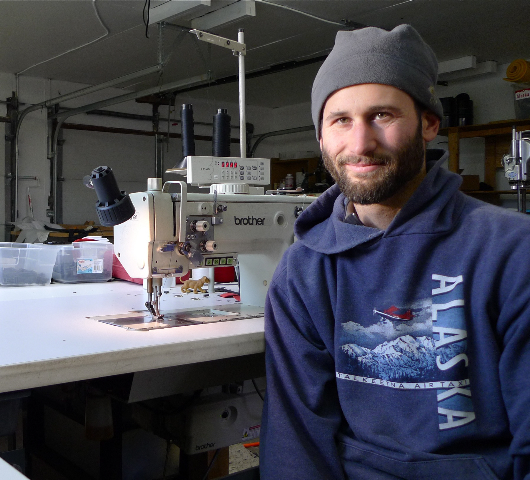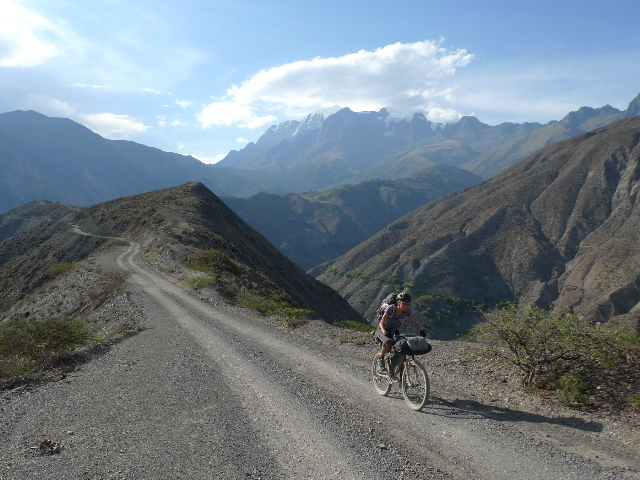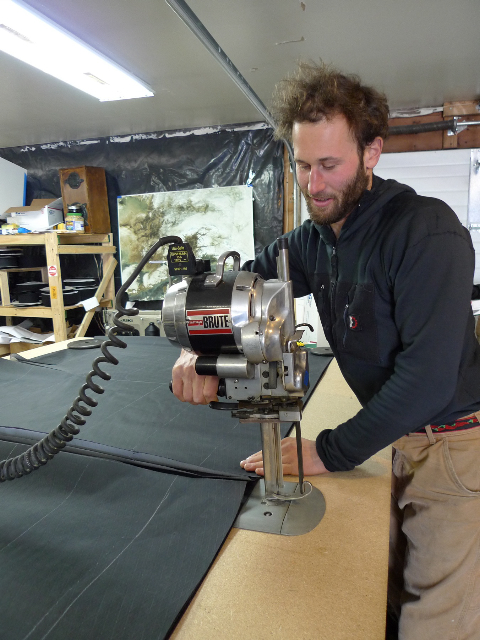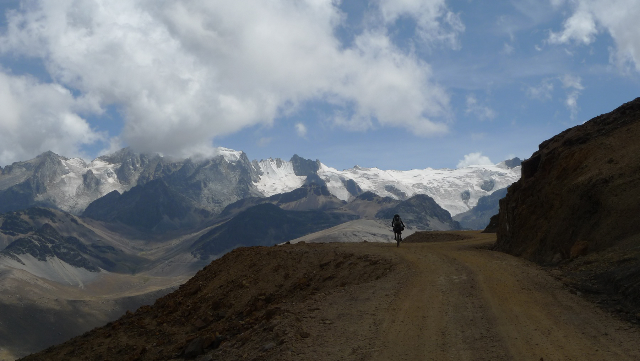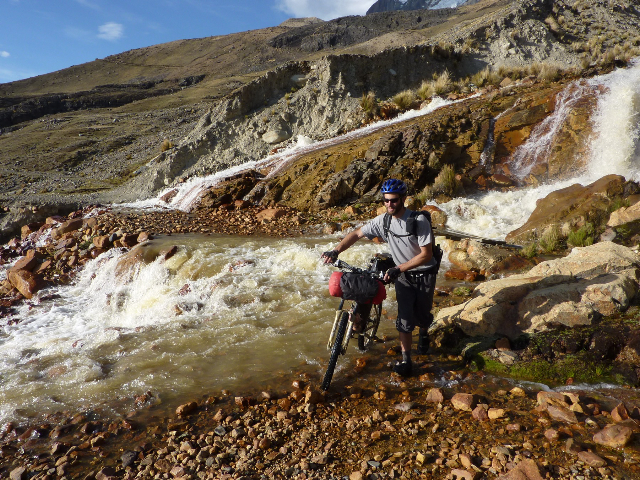Ah, a pull-on rain jacket for the ultralight community, that were my thoughts when I saw the Rab Demand Pull-On back in the day. A whooping 76 g lighter than my Rab Momentum jacket, made from the same 3 Layer eVent material, reduced to what is really necessary, yeah, I'd like to try that out indeed.
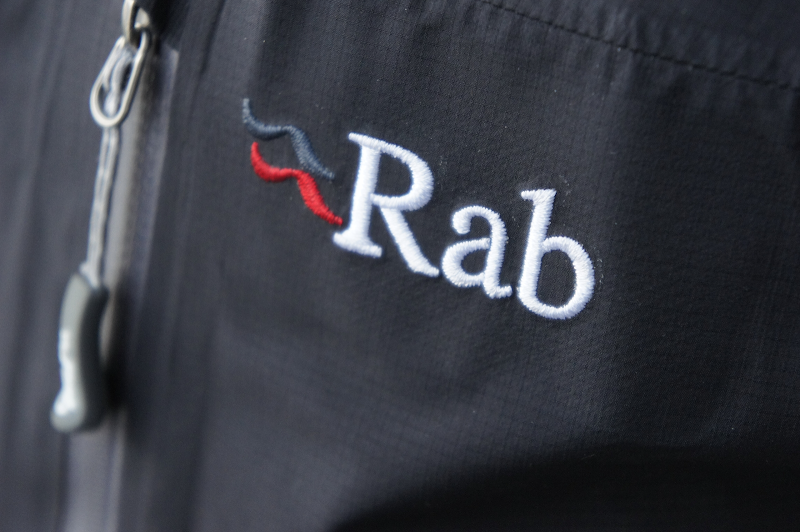
The important part: 252 g in Size S. It is Black. I like it.
The cut is spot on for me, a bit longer in the back to cover me buttocks, a front zipper which can be opened far to allow ventilation, a good hood and one front pocket, which is big enough for me to fit in my puukko, a map, compass and a chocolate bar. Rab says that the pocket ain't waterproof, which is sort of true: Keeping your phone in there is not recommended as it can get a bit moist; that moistness is however coming from the inside when the eVent membrane transports your sweat out. Keep gadgets in a waterproof bag and it is fine.
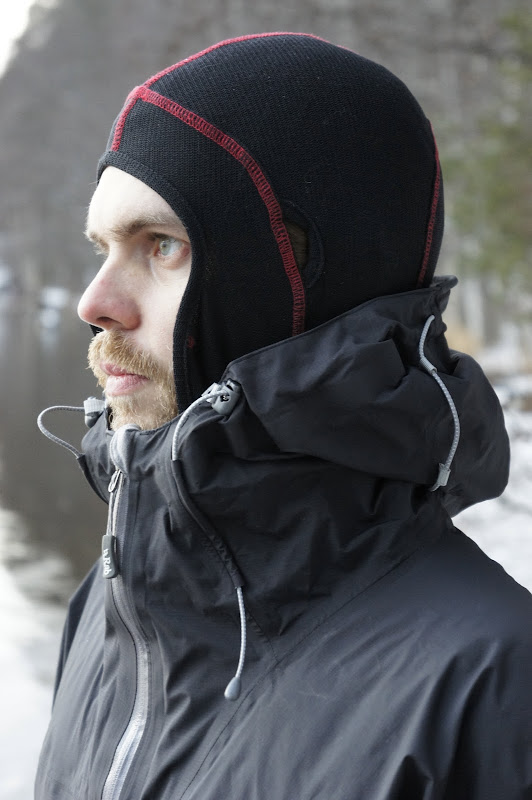
Hood off.

Hood on.
Speaking of hoods, I don't know why Rab didn't put the Momentum visor on the Demand. The Demand is like the reduced Momentum, sure, but why would you make the visor smaller? If you put a visor on a hood, make it big so that it has a full function and not just half of it. There's companies out there who make far worse hoods and visors, and this one is still good, but heck, why make it smaller?

The eVent membrane still kicks ass. I wore the Demand Pull-On every day in Russia and had no problems with sweat building up on the inside, while keeping the rain out. Also on subsequent outings - night orienteering in the snow, walking in the wind and rain - it kept me dry, warm and ventilated.

Wide open. Taped seams.
So it is a pullover, saving weight by not having a full zipper. If you follow me for a while already then you know that I like pullovers, and the Demand is no exception. The long front zipper facilitates getting in and out and allows for additional ventilation if needed. It is easy going as well, which is nice - no fiddling around in the cold or rain with it.

Longer in the back, short in the front, much like that 80s haircut.
With the pullover being longer in the back you wear it over your pants, so that water run-off doesn't get in them. Cover your buttocks to sit down where it is wet, though it isn't that long that you could loung in comfort, but for a short quick sit-down on a edge or tree it works fine. To round things out, elastic hand cuffs and a hem with a good drawcord keep the heat in, wind and wetness out.

Elastic cuffs. Standard, I'd say.
Any other shortcomings, you ask? Well, as all oil-based garments, keep away from fire. Sparks burn through eVent like a hot knife goes through butter, so be careful when sitting around the fire or feeding your Bushbuddy. Room for improvements? Just make the visor the same size than on the Momentum and I am happy.
What about the competition? Yeah, the Montane Spektr is lighter and also from eVent. But will it be available in black? It also has a new kind of front closure mechanism, but from what I have heard from my trusty sources, the functionality isn't quite there yet, but until I have seen and tried it myself judgement on it is out. Then there is the Haglöfs LIM OZO Pullover, which I also own, and it is even lighter (and unlike Rab, which are talking since over a year of getting a sustainability programme in place and there's still nada, Haglöfs is ISO 14.001 certified and is active in sustainability matters Edit: Information on Rab's Sustainability approach). I'll review it during next week, so stay tuned for intel on it.
To sum it up, a very nice Pullover, made of the highly breathable eVent material, with good features at an excellent price. It is the lightest full-feature 3 Layer eVent Smock currently on the market, and I can highly recommend it. If you want to lighten your load and are looking for a functional rain jacket, ähem, pullover, the Rab Demand Pull-On is what you might want to buy yourself for the holidays. The lads at the Outdoor Warehouse have it in stock with 10% off and will see to it that it arrives in time for putting it in your stockings/ under the tree.

The important part: 252 g in Size S. It is Black. I like it.
The cut is spot on for me, a bit longer in the back to cover me buttocks, a front zipper which can be opened far to allow ventilation, a good hood and one front pocket, which is big enough for me to fit in my puukko, a map, compass and a chocolate bar. Rab says that the pocket ain't waterproof, which is sort of true: Keeping your phone in there is not recommended as it can get a bit moist; that moistness is however coming from the inside when the eVent membrane transports your sweat out. Keep gadgets in a waterproof bag and it is fine.

Hood off.

Hood on.
Speaking of hoods, I don't know why Rab didn't put the Momentum visor on the Demand. The Demand is like the reduced Momentum, sure, but why would you make the visor smaller? If you put a visor on a hood, make it big so that it has a full function and not just half of it. There's companies out there who make far worse hoods and visors, and this one is still good, but heck, why make it smaller?

The eVent membrane still kicks ass. I wore the Demand Pull-On every day in Russia and had no problems with sweat building up on the inside, while keeping the rain out. Also on subsequent outings - night orienteering in the snow, walking in the wind and rain - it kept me dry, warm and ventilated.

Wide open. Taped seams.
So it is a pullover, saving weight by not having a full zipper. If you follow me for a while already then you know that I like pullovers, and the Demand is no exception. The long front zipper facilitates getting in and out and allows for additional ventilation if needed. It is easy going as well, which is nice - no fiddling around in the cold or rain with it.

Longer in the back, short in the front, much like that 80s haircut.
With the pullover being longer in the back you wear it over your pants, so that water run-off doesn't get in them. Cover your buttocks to sit down where it is wet, though it isn't that long that you could loung in comfort, but for a short quick sit-down on a edge or tree it works fine. To round things out, elastic hand cuffs and a hem with a good drawcord keep the heat in, wind and wetness out.

Elastic cuffs. Standard, I'd say.
Any other shortcomings, you ask? Well, as all oil-based garments, keep away from fire. Sparks burn through eVent like a hot knife goes through butter, so be careful when sitting around the fire or feeding your Bushbuddy. Room for improvements? Just make the visor the same size than on the Momentum and I am happy.
What about the competition? Yeah, the Montane Spektr is lighter and also from eVent. But will it be available in black? It also has a new kind of front closure mechanism, but from what I have heard from my trusty sources, the functionality isn't quite there yet, but until I have seen and tried it myself judgement on it is out. Then there is the Haglöfs LIM OZO Pullover, which I also own, and it is even lighter (
To sum it up, a very nice Pullover, made of the highly breathable eVent material, with good features at an excellent price. It is the lightest full-feature 3 Layer eVent Smock currently on the market, and I can highly recommend it. If you want to lighten your load and are looking for a functional rain jacket, ähem, pullover, the Rab Demand Pull-On is what you might want to buy yourself for the holidays. The lads at the Outdoor Warehouse have it in stock with 10% off and will see to it that it arrives in time for putting it in your stockings/ under the tree.
